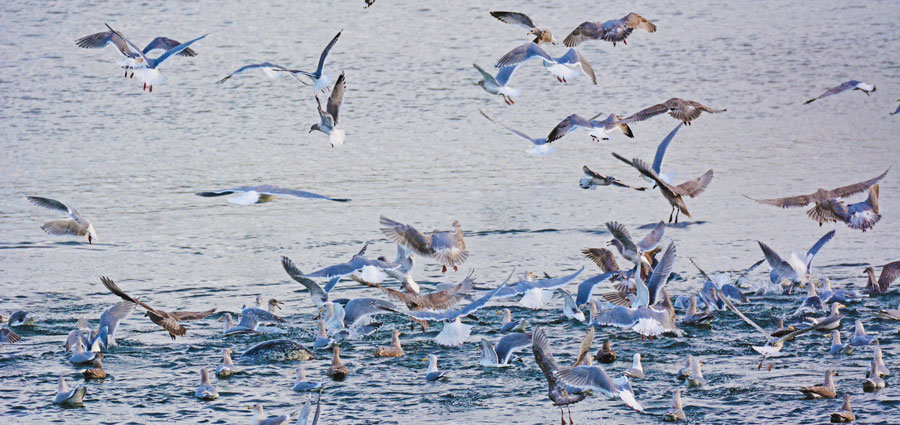
A commotion has been building outside. It has been building for days now. Some sort of forage fish is massing along the shoreline, and it has drawn a feeding frenzy of gulls, mergansers, cormorants, seals and eagles from miles around. Even slow to migrate loons have appeared in their snappy breeding plumage to partake.
The action swells and subsides like the tide as the hours pass. Screaming and diving and splashing give way to drifting and gliding and digesting when the fish vanish into deeper water. Seals let the tide carry them where it will. Then the fish reappear. Caspian terns plunge into the fray from great heights. I thought the sea lions had finally left for the year, but they arrive — and everyone knows it when they do. Late into the night their belligerent barks ring across the Sound.
In the morning the fracas continues. We count at least 15 eagles in the area. Last year when this happened, there were over 60. Far into the forest I can hear the gulls. My fly fisherman neighbor goes down to investigate, and reports that most of the fish are anchovies, with smaller schools of young chum salmon.
For several years now I have been attempting to parse out the anatomy of these feeding frenzies. They happen spontaneously throughout winter and spring and can be as short as 15 minutes or as long as a week.
How do they begin? Who finds the fish? How does word spread? Which species are early arrivers, and which come later? When the fish vanish, how are they rediscovered? When do the feeders decide it is time to disperse?
That’s what I mean by the anatomy. I guess I’m trying to study an ecosystem of many parts rather than an individual, except here it’s also an event. A party.
And it’s anchovies, which reminds me of “Cannery Row” and what John Steinbeck wrote in that wonderfully aimless book’s culminating chapter: “The nature of parties has been imperfectly studied. It is, however, generally understood that a party has a pathology, that it is a kind of an individual and that it is likely to be a very perverse individual. And it is also generally understood that a party hardly ever goes the way it is planned or intended.”
Steinbeck treated “Cannery Row” like a tidepool rather than a plot, patiently sitting with his characters and letting their stories crawl onto the page rather than forcing the characters to be servants to some final destiny. The party that ends the book is as meandering as the book itself, by turns awkward, energetic, ecstatic, weepy, disorderly, saccharine, sleepy. It’s a delight to read. It’s like the feeding frenzies.
Sometimes seals drive the action. Sometimes cormorants. Sea lions may start it or finish it. Though I want to see more before drawing any firm conclusions, I have yet to find an overarching pattern. I like Steinbeck’s use of the word pathology, despite its connotations, and the ease with which he compares individuals to groups to parties. The scientist and the novelist in me want these phenomena to have set pathways, discernible arcs, while the earthy kid who’s now lived decades on this planet knows that everything is contingent upon circumstance — who happens to find the fish, chance encounters thereafter, the half-inches that separate success from failure in hunting.
With patience, we learn the general strategies of the participants. Mergansers cruise the bays in small packs like wolves and are often the first to locate fish. Bald eagles arrive late, when a certain level of hoopla has been achieved, since they prefer to steal fish rather than catch them. Gulls are particularly strange. They seem to exist to stir up the party, to thrive on yelling and fighting and generally creating a moving mob that attracts the attention of everyone around. Why? Wouldn’t it make more sense for a bird to be sneaky when it finds food, to avoid the competition?
Maybe they thrive on chaos. Maybe when the party runs loose and half-eaten fish are flying, gulls are happiest. They’re generalists, after all, like us. They may not be able to dive underwater or fly upside down, but they sure can react quickly when the scene is complex. They’re one of the few birds with eyes that move in their sockets.
For now, as a student of feeding frenzies, I’d do well to learn from the gulls. My scribbled notes are full of discoveries but no grand theory is forthcoming. How could it be? Whenever a new frenzy begins, half-eaten observations start flying and the questions follow in a flurry that is as unpredictable as life itself: What drives the anchovies toward shore? What else is underwater? How far can a cormorant see down there? How do eagles know what’s going on from miles away? How do seals? Do these animals intentionally communicate with each other, between species?
I keep my eyes open. I try to get to know the partygoers, but that’s a far cry from knowing how the party will go.
UNDERWRITTEN BY THE FUND FOR NONPROFIT NEWS (NEWSMATCH) AT THE MIAMI FOUNDATION, THE ANGEL GUILD, ADVERTISERS, DONORS AND PEOPLE WHO SUPPORT INDEPENDENT, NONPROFIT LOCAL NEWS